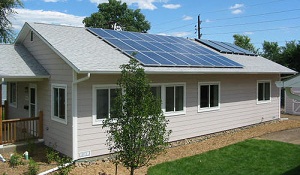Riverside, Calif., finally offering payments to net-metering customers
 As California’s renewable energy laws come into effect, utilities, towns and cities are working to come into compliance with the state’s net-metering and feed-in tariff rules.
As California’s renewable energy laws come into effect, utilities, towns and cities are working to come into compliance with the state’s net-metering and feed-in tariff rules.
For instance, Riverside, Calif.’s Public Utility today passed its proposed net-metering rate of 5.8 cents per kilowatt hour to the city council. The net-metering rate applies to utility customers with a photovoltaic (PV) system or other renewable energy system like wind.
“Under the new law, we have to compensate people who are net producers,” said Jerry Buydos, solar projects manager for the utility.
Previously, net producers were able to carry any net excess generation over for a 12 month period and apply excess generation toward future bills. At the end of the period, any net excess generation was gifted to the utility without compensation, he explained.
But that has changed.
“It’s part of the net-metering agreement to compensate people who are net producers.” He said that the utility now “trues up” with customers after a 12 month period.
The utility will begin reimbursing customers in January, 2011, under the new law (enabled by the passage of AB 920). At its onset, Buydos said the utility projects it will pay $6,600 annually to its net-metering customers. The utility foresees that 31 out of its 200 net-metering customers will receive payouts for their excess generation in 2011.
That number is likely to grow. The renewable rebate incentive program offered by Riverside Public Utilities—and other California utilities—is extremely popular. And while you don’t have to receive funds to net-meter, it significantly lowers the up-front costs of installing a system.
Under Riverside’s program, the utility offers residents 4 cents per watt for installed PV, up to $16,000 for residents (3 cents per watt and $50,000 for small businesses), according to Buydos.
“Each customer cannot exceed 120 percent of their historic usage,” he said. “It gives some room in case people add in more electric usage at home.”
He added that the utility doesn’t expect many people to become true net producers. “We want the customer to zero-out their bill,” he said.
But if you want to get funding for a PV system through the utility, hurry up!
“Both [the small business and residents] are fully funded for current period,” Buydos said. “I have pages of people waiting.”
He added that the next funding period will start in July 2011.
Pictured: Habitat for Humanity, along with Riverside Public Utilities, installed PV on this home, courtesy of RPUC.



